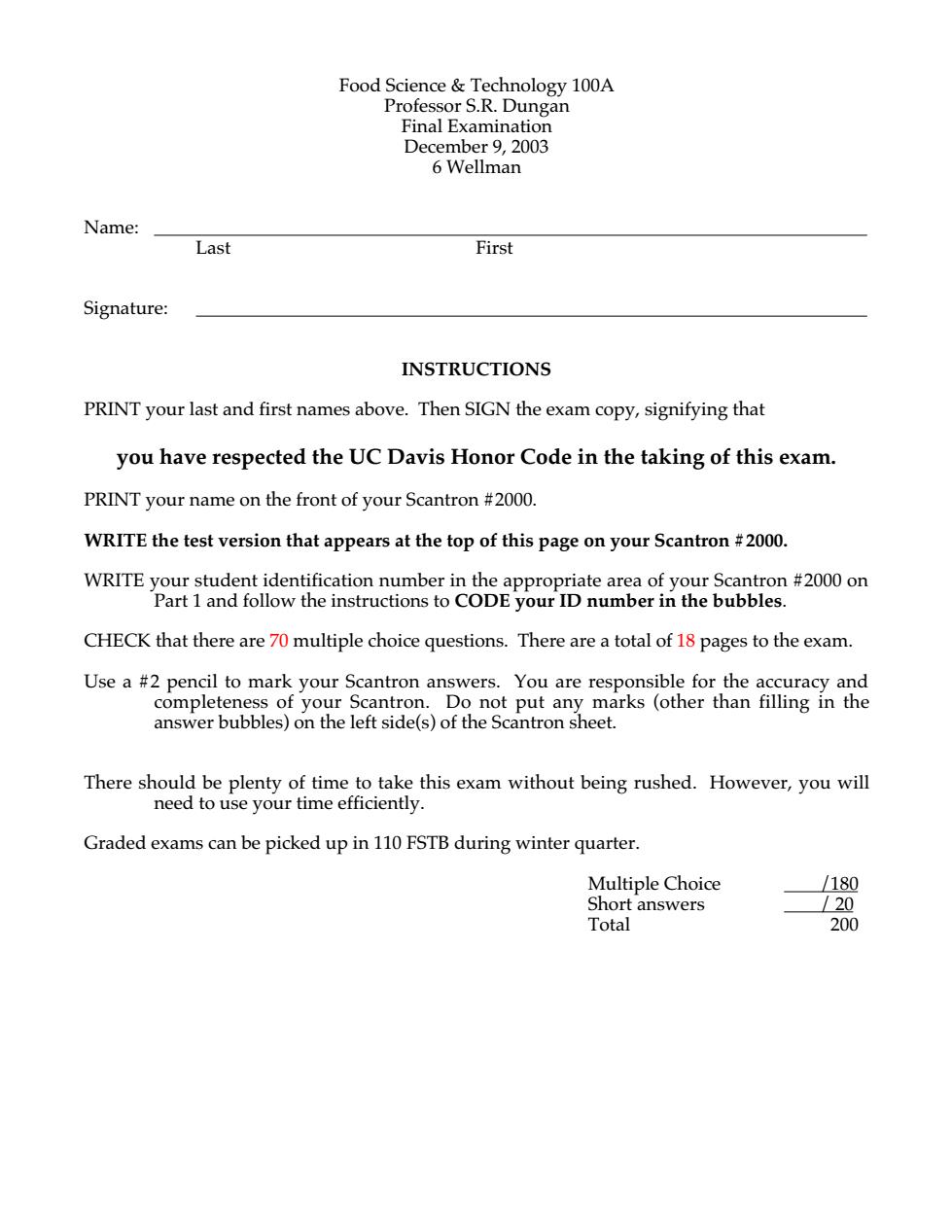
FodsaeotRtcea1oA Final Examination December 9,2003 6 Wellman Name: Last First Signature: INSTRUCTIONS PRINT your last and first names above.Then SIGN the exam copy,signifying that you have respected the UC Davis Honor Code in the taking of this exam. PRINT your name on the front of your Scantron #2000. WRITE the test version that appears at the top of this page on your Scantron #2000. CHECK that there are 70 multiple choice questions.There are a total of 18 pages to the exam Use a #2 pencil to mark your Scantron answers.You are res onsible for the accuracy and of marks (other than filling in the There should be plenty of time to take this exam without being rushed.However,you will need to use your time efficiently. Graded exams can be picked up in 110 FSTB during winter quarter. Mulipe Choice Total answers 200
Food Science & Technology 100A Professor S.R. Dungan Final Examination December 9, 2003 6 Wellman Name: Last First Signature: INSTRUCTIONS PRINT your last and first names above. Then SIGN the exam copy, signifying that you have respected the UC Davis Honor Code in the taking of this exam. PRINT your name on the front of your Scantron #2000. WRITE the test version that appears at the top of this page on your Scantron #2000. WRITE your student identification number in the appropriate area of your Scantron #2000 on Part 1 and follow the instructions to CODE your ID number in the bubbles. CHECK that there are 70 multiple choice questions. There are a total of 18 pages to the exam. Use a #2 pencil to mark your Scantron answers. You are responsible for the accuracy and completeness of your Scantron. Do not put any marks (other than filling in the answer bubbles) on the left side(s) of the Scantron sheet. There should be plenty of time to take this exam without being rushed. However, you will need to use your time efficiently. Graded exams can be picked up in 110 FSTB during winter quarter. Multiple Choice /180 Short answers / 20 Total 200
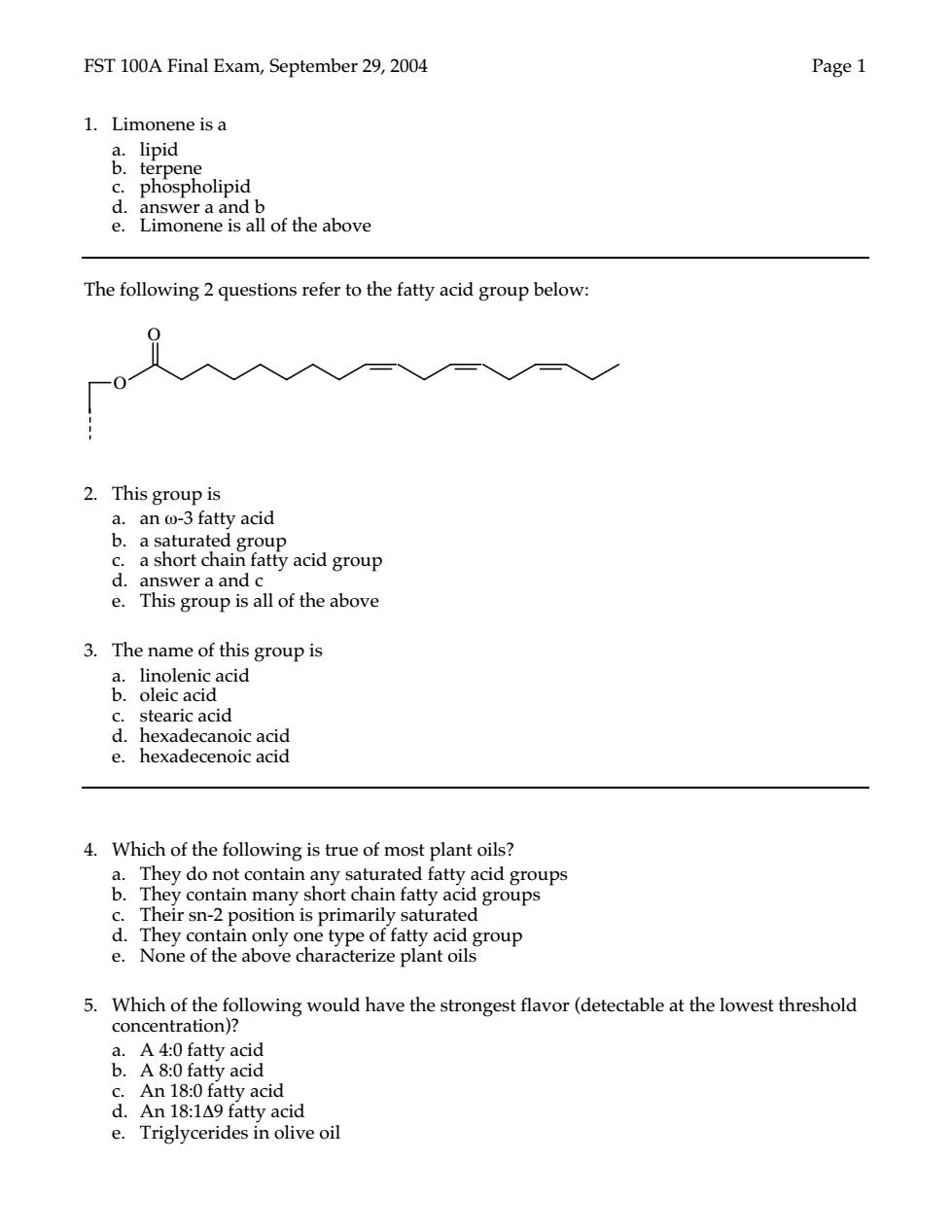
FST 100A Final Exam,September 29,2004 Page 1 1.Limonene is a phospholipid lof the above monene Is The following 2 questions refer to the fatty acid group below. 2.This group is an-3 fatty acid anshort ura atty acid group e 3.The name of this group is mleaacd id c stearic acid d.hexadecanoic acid e.hexadecenoic acid 4.Which of the following is true of most plant oils? 》a groups d.Thev fatty e.None of the aboye characterize plant oilsoup onta 5.Which of the following would have the strongest flavor(detectable at the lowest threshold &A知aa concentration)? A 8-0 fatty acid An 18:0 fatty acid d.An18:1△9 fatty acid e.Triglycerides in olive oil
FST 100A Final Exam, September 29, 2004 Page 1 1. Limonene is a a. lipid b. terpene c. phospholipid d. answer a and b e. Limonene is all of the above The following 2 questions refer to the fatty acid group below: 2. This group is a. an ω-3 fatty acid b. a saturated group c. a short chain fatty acid group d. answer a and c e. This group is all of the above 3. The name of this group is a. linolenic acid b. oleic acid c. stearic acid d. hexadecanoic acid e. hexadecenoic acid 4. Which of the following is true of most plant oils? a. They do not contain any saturated fatty acid groups b. They contain many short chain fatty acid groups c. Their sn-2 position is primarily saturated d. They contain only one type of fatty acid group e. None of the above characterize plant oils 5. Which of the following would have the strongest flavor (detectable at the lowest threshold concentration)? a. A 4:0 fatty acid b. A 8:0 fatty acid c. An 18:0 fatty acid d. An 18:1∆9 fatty acid e. Triglycerides in olive oil O O
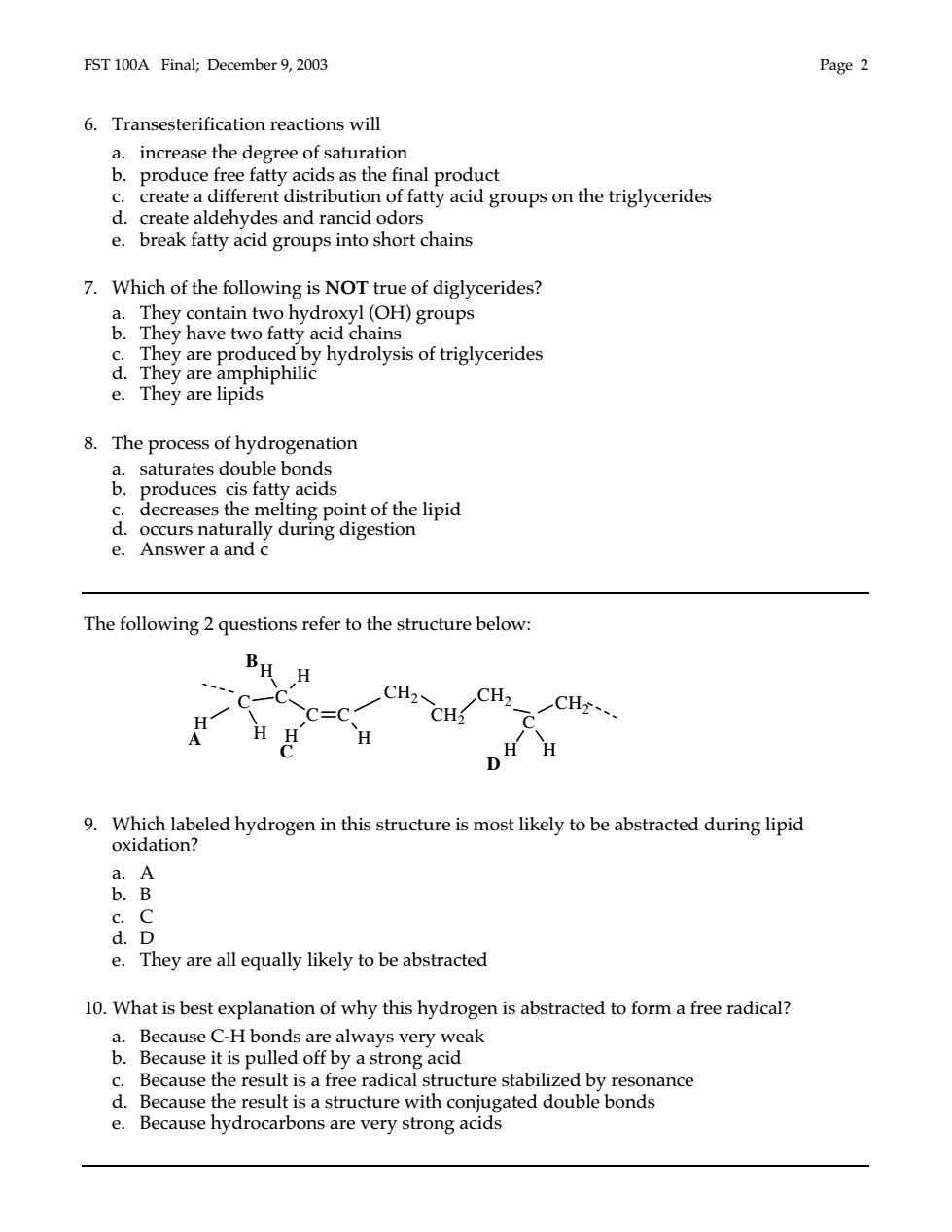
EST 100A Final:December 9.2003 Page2 6.Transesterification reactions will a.increase the degree of saturation b.produce free fatty acids as the final product c.create a different distribution of fatty acid groups on the triglycerides d.create aldehydes and rancid odors e.break fatty acid groups into short chains 7.Which of the following is NOT true of diglycerides? a.They contain two hydroxyl(OH)groups b.They have two fatty acid chains They are produced by hydrolysis of triglycerides e.They are lipids 8. The process of hydrogenation Proac produces cis fatty acids a decreases the melting point of the lipid e. Aseraana2digdgaion The following 2 questions refer to the structure below: BH H CH2 CC=C cHCH一CH H DH H 9.Which labeled hydrogen in this structure is most likely to be abstracted during lipid oxidation? B c.C d.D e.They are all equally likely to be abstracted 10.What is best explanation of why this hydrogen is abstracted to form a free radical? a.Because C-H bonds are always very weak Because it is pulled off by a stro ong acid Because the sult is a f adical st cture stabilized by Bcause的doaihoaaega2gmedoubtond Ie: esult i is a structure with conj
FST 100A Final; December 9, 2003 Page 2 6. Transesterification reactions will a. increase the degree of saturation b. produce free fatty acids as the final product c. create a different distribution of fatty acid groups on the triglycerides d. create aldehydes and rancid odors e. break fatty acid groups into short chains 7. Which of the following is NOT true of diglycerides? a. They contain two hydroxyl (OH) groups b. They have two fatty acid chains c. They are produced by hydrolysis of triglycerides d. They are amphiphilic e. They are lipids 8. The process of hydrogenation a. saturates double bonds b. produces cis fatty acids c. decreases the melting point of the lipid d. occurs naturally during digestion e. Answer a and c The following 2 questions refer to the structure below: 9. Which labeled hydrogen in this structure is most likely to be abstracted during lipid oxidation? a. A b. B c. C d. D e. They are all equally likely to be abstracted 10. What is best explanation of why this hydrogen is abstracted to form a free radical? a. Because C-H bonds are always very weak b. Because it is pulled off by a strong acid c. Because the result is a free radical structure stabilized by resonance d. Because the result is a structure with conjugated double bonds e. Because hydrocarbons are very strong acids C C H H H H H H C C A B C D CH2 CH2 CH2 C CH2 H H
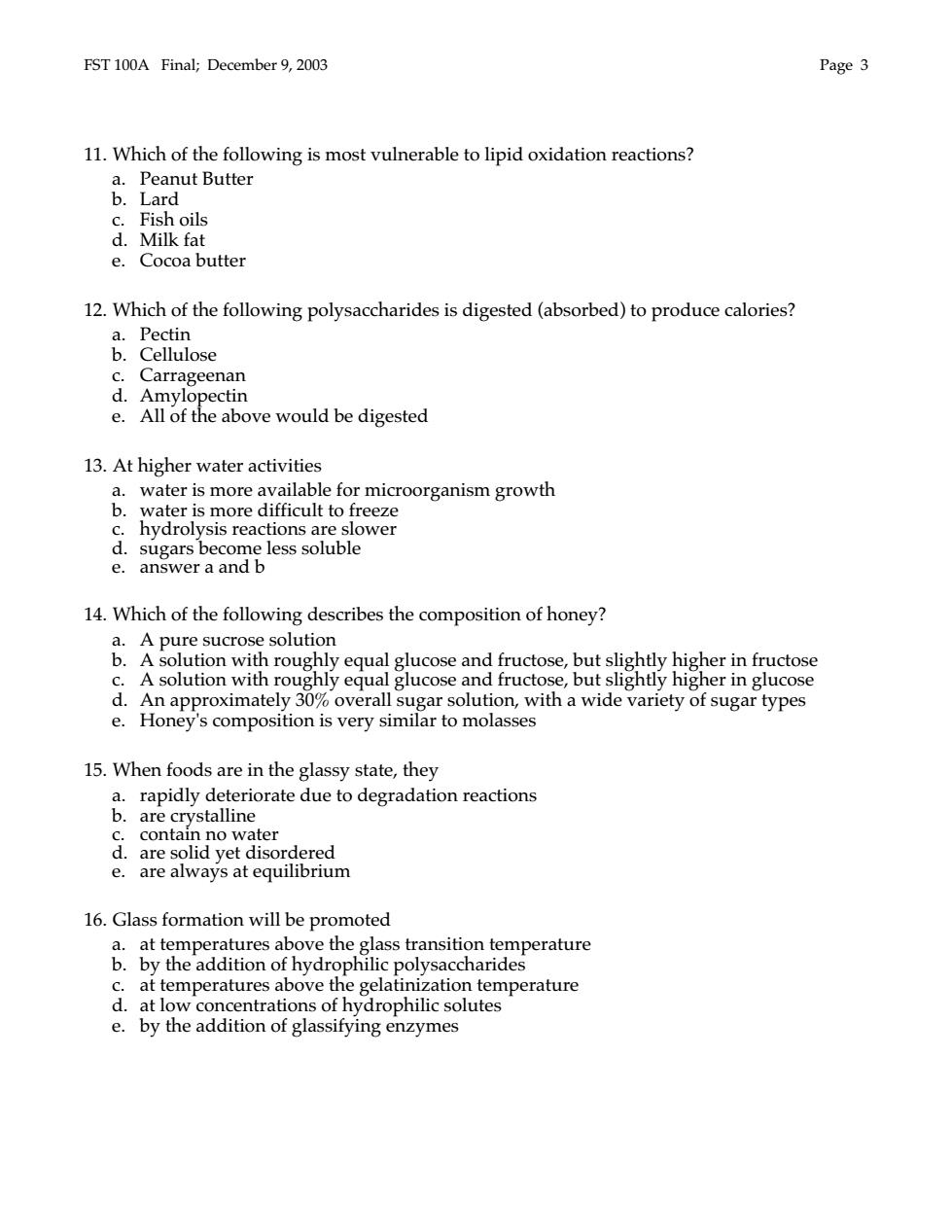
FST 100A Final;December 9,2003 Page3 11.Which of the following is most vulnerable to lipid oxidation reactions? a.Peanut Butter b.Lard c.Fish oils d.Milk fat e.Cocoa butter 12.Which of the following polysaccharides is digested(absorbed)to produce calories? a.Pectin b.Cellulose Carrageenan ectin e.All of the above would be digested 13.At higher water activitie water is more available for microorganism growth is more we s h e.answer a and b 14.Which of the following describes the composition of honey? B.puresucrose solution A solution with roughly equal glucose and fructose,but slightly higher in fructose a A solution with roughly equal glucose and fructose,but slightly higher in glucose An approximately 30%overall sugar solution,with a wide variety of sugar types e. Honey's composition is very similar to molasses 15.When foods are in the glassy state,they .rate due to degrdaion reactions are cr n no water e. 16.Glass formation will be promoted a.at temperatures above the glass transition temperature b.by the addition of hydrophilic polysaccharides c.at temperatures above the gelatinization temperature d.at low concentrations of hydrophilic solutes e.by the addition of glassifying enzymes
FST 100A Final; December 9, 2003 Page 3 11. Which of the following is most vulnerable to lipid oxidation reactions? a. Peanut Butter b. Lard c. Fish oils d. Milk fat e. Cocoa butter 12. Which of the following polysaccharides is digested (absorbed) to produce calories? a. Pectin b. Cellulose c. Carrageenan d. Amylopectin e. All of the above would be digested 13. At higher water activities a. water is more available for microorganism growth b. water is more difficult to freeze c. hydrolysis reactions are slower d. sugars become less soluble e. answer a and b 14. Which of the following describes the composition of honey? a. A pure sucrose solution b. A solution with roughly equal glucose and fructose, but slightly higher in fructose c. A solution with roughly equal glucose and fructose, but slightly higher in glucose d. An approximately 30% overall sugar solution, with a wide variety of sugar types e. Honey's composition is very similar to molasses 15. When foods are in the glassy state, they a. rapidly deteriorate due to degradation reactions b. are crystalline c. contain no water d. are solid yet disordered e. are always at equilibrium 16. Glass formation will be promoted a. at temperatures above the glass transition temperature b. by the addition of hydrophilic polysaccharides c. at temperatures above the gelatinization temperature d. at low concentrations of hydrophilic solutes e. by the addition of glassifying enzymes
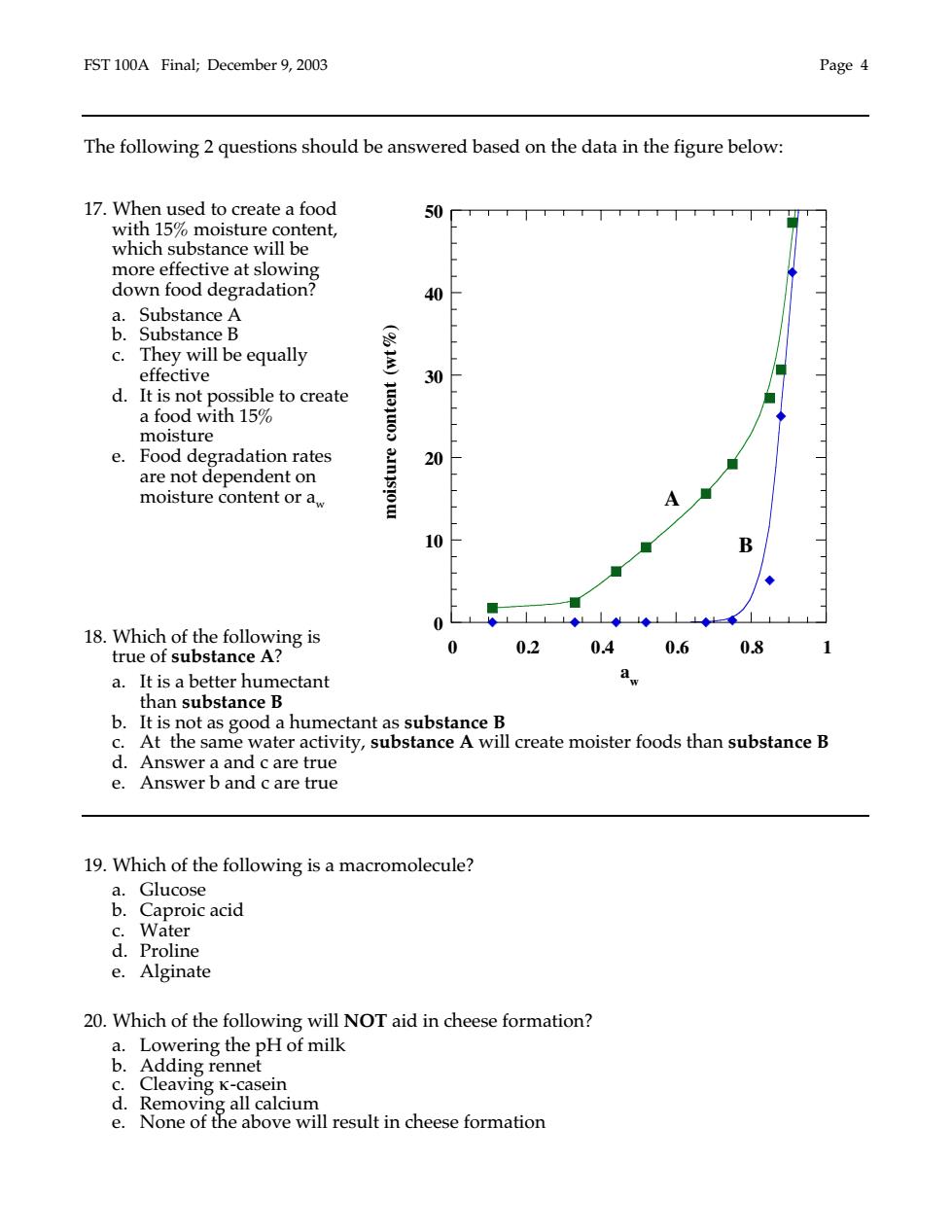
EST 100A Final:December 9.2003 Page 4 The following 2 questions should be answered based on the data in the figure below: 17.When used to create a food 50 with 15%moisture content, which substance will be more effective at slowing down food degradation? 40 &Substanc合 c.They will be equally effective 30 d.It is not possible to create a food with 15 moisture e.Food degradation rates 20 are not dependent on moisture content or a, 0 0 18Wibdc6soegAg8s 0 0.2 0.4 0.6 0.8 a.It is a better humectant b.It is not as good a humectant as substance B c.At the same water activity,substance A will create moister foods than substance B d.Answer a and c are true e.Answer b and c are true 19.Which of the following is a macromolecule? .Cproie acid c Water d.Proline e.Alginate 20.Which of the following will NOT aid in cheese formation? a.Lowering the pH of milk Adding rennet Cleaving K- seir calcium ove wI ill result in cheese formation
FST 100A Final; December 9, 2003 Page 4 The following 2 questions should be answered based on the data in the figure below: 17. When used to create a food with 15% moisture content, which substance will be more effective at slowing down food degradation? a. Substance A b. Substance B c. They will be equally effective d. It is not possible to create a food with 15% moisture e. Food degradation rates are not dependent on moisture content or aw 18. Which of the following is true of substance A? a. It is a better humectant than substance B b. It is not as good a humectant as substance B c. At the same water activity, substance A will create moister foods than substance B d. Answer a and c are true e. Answer b and c are true 19. Which of the following is a macromolecule? a. Glucose b. Caproic acid c. Water d. Proline e. Alginate 20. Which of the following will NOT aid in cheese formation? a. Lowering the pH of milk b. Adding rennet c. Cleaving κ-casein d. Removing all calcium e. None of the above will result in cheese formation 0 10 20 30 40 50 0 0.2 0.4 0.6 0.8 1 aw moisture content (wt%) A B